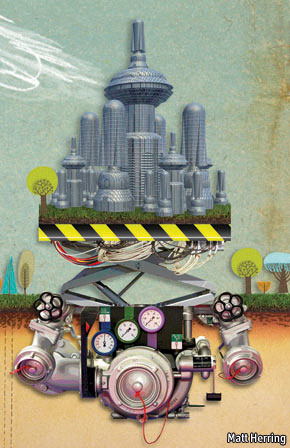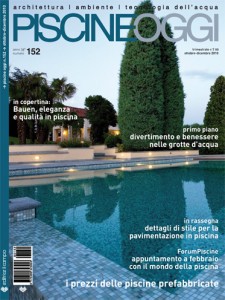03.20.2011
Can Designer Power Masts Win Over the Public?
By Christina Schmidt
Europe is undergoing a revolution in energy production that requires massive new infrastructure to support the shift to renewables. But do new power lines always have to result in blight? Some utility companies are hoping that designer power masts can help overcome local opposition. Erik Bystrup gets enthusiastic when the talk turns to power transmission masts. Standing in front of one of his masts, the Danish architect uses words like “elegance” and “beauty” and talks about how pleased he is that transmission masts are finally no longer dotting the landscape like “giant sad men.”
There is a simple reason behind Bystrup’s passionate words: His masts are not ordinary steel structures but art. To improve the Danes’ acceptance of the poles, which are visible at great distances, the architect designed modern masts that look like abstract crowns or eagles’ wings.
read full article
01.05.2011
The rising sea waters caused by global warming have inspired a Russian architect to design a hotel that could be built on water as well as land. The eco-friendly ”Ark” could be constructed in just a few months anywhere in the world, the designer says.
It’s called “The Ark”, but looks more like a ship sitting upside down on the water. A new design by Russian architect Alexander Remizov challenges the tradition of land-based hotel living and would provide a refuge in the future — should the world face a modern-day flood of Biblical proportions.
Remizov designed the hotel as part of a program on architecture and disaster relief through the International Union of Architects (UIA). He collaborated with a German design and engineering firm and the Moscow-based scientist Lev Britvin, who, according to Remizov, has developed energy-saving solutions for space stations. They are now searching for investors to make the design a reality.
read full article
12.21.2010
Westwood, CA
Photo Illustration by Hubert Blanz
By JONAH LEHRER
Published: December 17, 2010
Geoffrey West doesn’t eat lunch. His doctor says he has a mild allergy to food; meals make him sleepy and nauseated. When West is working — when he’s staring at some scribbled equations on scratch paper or gazing out his office window at the high desert in New Mexico — he subsists on black tea and nuts. His gray hair is tousled, and his beard has the longish look of neglect. It’s clear that West regards the mundane needs of everyday life — trimming the whiskers, say — as little more than a set of annoying distractions, drawing him away from a much more interesting set of problems. Sometimes West can seem jealous of his computer, this silent machine with no hungers or moods. All it needs is a power cord.
read full article
12.09.2010
Westwood, California
The prominent and influential PISCINE OGGI (Pool Today) Italian Magazine ran an article in its October-December, 2010 issue on atelier V: architecture’s design of the pool structure and remodel of the Gerrity Residence in Beverly Hills, CA completed in 2009. To view the article please go to : http://www.piscineoggi.it/piscine_oggi_sommari.html
You can also download the PDF file of the article at www.atelierv.com , go to Projects/Residential/Gerrity Residence and click on the right hand pull out menu.
atelier V would like to thank Alice Spiga of Piscine Oggi for taking note of our project and publishing it.
For those who never saw the original article in Vews, we are republishing it below :
The house at 1285 Angelo Drive in Beverly Hills, California started out as a tired looking cliffhanger badly in need of a yard of its own. Fortunately, the owners Tim and Jill Gerrity had the stamina to stick through months of battles in filing for conditional use permits, variances and sitting through neighborhood hearings to finally secure the permit for an unprecedented new concrete yard and pool structure. While at it, Gerritys decided to overhaul the residence by asking atelier V to give it a new entry sequence and an entrance tower, a new expanded driveway and whole new Tuscan appearance. The result is a complete transformation.
read full article
11.15.2010
http://www.economist.com/node/17388308
For cities to become truly smart, everything must be connected

IN SINGAPORE conversations about water quickly turn political. The city-state no longer wants to depend on water from Malaysia when the current water-supply agreement between the two countries expires in 2061. More than once the neighbour to the north, of which Singapore was part before an acrimonious split in 1965, has threatened to increase prices or even cut off supplies. Yet politics is not the only reason for Singapore’s advanced water system. The information centre at the Marina Barrage features pictures of floods and droughts. “We have either too much water or too little,” explains Yap Kheng Guan, a director of Singapore’s PUB. Even today, despite a sophisticated system of ditches and tunnels, floods can suddenly strike. In July parts of the main shopping district were under water after heavy rainfalls. The problems of scarcity and excess are in evidence on the city-state’s roads too. Singaporeans, who are among the world’s richest people, love to drive, but space for roads is severely limited. When in the early 1970s the central area became too congested, the government introduced the world’s first manual urban road-pricing system. In 1998 it became the first to be automated. “Singapore proves that necessity is the mother of invention,” says Teo Lay Lim, who heads the local office of Accenture. In this special report •It’s a smart world •A sea of sensors •Making every drop count •» Living on a platform « •Augmented business •The IT paydirt •Your own private matrix •Sensors and sensibilities •Horror worlds •Sources and acknowledgments •Offer to readers Now the city wants to become a “living laboratory” for smart urban technologies of all kinds—not just water and transport systems but green buildings, clean energy and city management too. Both local and foreign firms in these sectors will be able to develop and show off their products on the island before selling them elsewhere, explains Goh Chee Kiong, who is in charge of the clean-energy cluster at Singapore’s Economic Development Board. There is strong demand for making cities smarter, not just in China and other rapidly urbanising countries but throughout the Western world. Resources like water, space, energy and clean air are scarce in urban areas, which makes them the natural place to start saving, says Mark Spelman, Accenture’s global head of strategy. “Smart-city” projects have been multiplying around the world. Some of them are not as new as their labels suggest, and in any case what exactly constitutes a smart city is hard to define. But they all have one thing in common: they aim to integrate the recent efforts to introduce smart features in a variety of sectors and use this “system of systems”, as IBM calls it, to manage the urban environment better. The best-known smart city is Masdar, a brand-new development in Abu Dhabi that recently welcomed its first residents and will eventually become home to 40,000 people. It is being built entirely on a raised platform, which makes maintenance and the installation of new gear much easier. Below the platform sits the smart infrastructure, including water pipes with sensors and a fibre-optic network. Above it is to be a showcase for all kinds of green technology: energy-efficient buildings, small pods that will zoom around on paths (no cars will be allowed) and systems that catch dew as well as rainwater. Yet experts see Masdar mostly as a property project: hardware in search of a purpose. What really matters to a city’s smartness, they argue, is the software that runs on it and the network that connects its parts. “It is the common infrastructure for all the smart systems,” says Wim Elfrink, who heads the “Smart+Connected Communities” initiative of Cisco, the networking-equipment maker.
read full article
11.02.2010
http://www.metamute.org/en/articles/zaha_hadid_architects
Zaha Hadid Architects and the Neoliberal Avant-Garde
“….an architecture of spectacular, hollow unreality: based on unreal money, housing unreal programmes. This unreality has infused architectural production, often finding resolution in hysterical, liquid, fluid form at audacious scale – the kind of thing recently dubbed ‘Parametricism’ by Patrik Schumacher.’ The ideas of ‘differentiation’, the opposition to the ‘fixed’, has its own economic correspondent..” says Sam Jacob
By Owen Hatherley
Is it possible to be both builders of the prestige spaces of capital and self-declared avant-gardists? Owen Hatherley takes a look at the fluid architecture and financial times of Zaha Hadid Architects The New Avant-Garde Acknowledges its Precursors This summer, there was an exhibition at the Galerie Gmurzynska in Zurich entitled Zaha Hadid and Suprematism. It was a ‘dialogue’ between the Anglo-Iraqi architect, winner of the 2010 Stirling Prize – and her apparent forbears, the 1920s Soviet avant-garde, as her flowing, bristling forms whipped through rooms containing works by Kasimir Malevich, Alexander Rodchenko, Nikolai Suetin and El Lissitzky.
read full article











